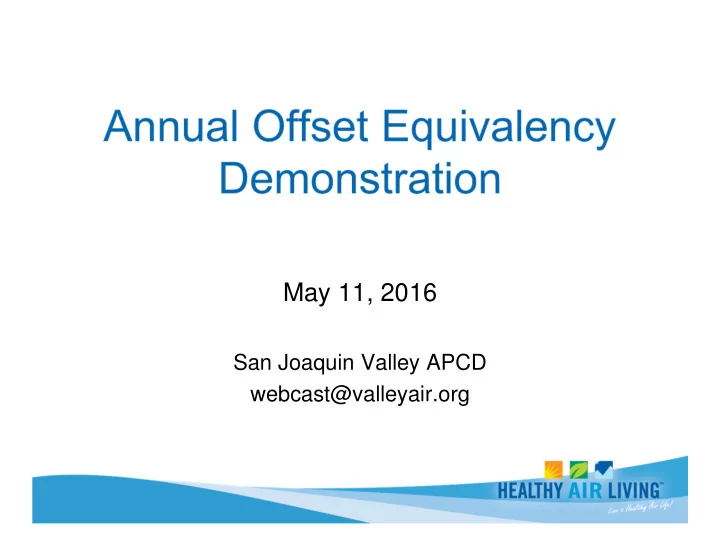

May 11, 2016 San Joaquin Valley APCD webcast@valleyair.org
• Rule 2201 (New Source Review), Section 7 • Purpose is to demonstrate equivalency: District’s offset requirements versus Federal offset requirements
• District’s current offsetting requirements adequate under all conditions for all minor projects: – New sources that are not major – Modifications that are not federal major modifications (even at major sources) • Can offset emissions with any valid credits • No surplussing-at-time-of-use
• District offsetting requirements are more strict overall: – Higher offset ratios – Lower offsetting thresholds – Portion (10%) of all original banking actions goes to clean air • More offsets required than federal program • After annual equivalency demonstration, leftover credits carry-over to subsequent years
• First test: Compares federal offset requirements to offsets required by District program • Second test: Compares federal offset requirements to surplus portion of District offsets (surplus reductions are in excess of requirements in existence on the date when the permit is issued)
Schedule for Report • Annual equivalency demonstration period is August 20 to August 19 • Report due to EPA on November 19 of each year • All reports available on District website, valleyair.org
• Successful for the last thirteen years for all pollutants • Tracking system potential failure for NOx this coming year • If fail, November 19, 2016 report due date triggers ramifications for Authority to Construct permits issued on and after that date
1800 1624 1600 1400 1319 1200 957 1000 Tons-NOx 786 800 698 658 600 400 200 12 0 2009 2010 2011 2012 2013 2014 2015 8
• New major sources and federal major modifications required to use surplus-at-time- of-use credits – Does not affect minor projects • Ramification in place until subsequent annual report is submitted showing no failure • Likely significant impact on prices/availability of offsets for such projects
• District performed detailed evaluation of our NOx ERC Bank • Surplus values methodology: – Identify original banking project – Determine source type and emission factors used to calculate actual emission reductions – Evaluate current rules and regulations applicable to original banking action to determine the surplus value of credits
• Approximately 18% of NOx ERC credits available for surplus-at-time-of-use – About 1,000 tons of NOx credits • May seem large, but a few large projects could significantly reduce available credits • May impact the ability for any future growth in the San Joaquin Valley • Current offset program not sustainable for long-term equivalency
• Ongoing: Identify and revisit unimplemented ATC projects requiring federal offsets – Applicant can cancel or modify ATCs not implemented – Return surplus reductions used to mitigate past project emissions increases • Ongoing: work with applicants to reduce emissions – Avoid Major Modifications – Minimize offset requirements
• Advantages – No changes to current rules – Facilities who benefit most would likely be the ones who would voluntarily participate • Disadvantages – No guarantees of participation – Short timeframes to identify and surrender ERCs • Surplus amounts needed, only determined after August – Creates a high level of uncertainty for equivalency demonstration
• Approach #1 – Only facilities with projects requiring federal offsets required to make up shortfall • Approach #2 – All stationary sources required to make up shortfall • Advantages – More certainty that a mechanism exists • Disadvantages – Short timeframes to identify and surrender ERCs – Unfair to non-Major Source facilities that do not benefit from equivalency demonstration
• Allowed per Rule 2201 (Section 4.13.3.1.4) • Robust carry-over surplus amount of VOCs – 1,657 tons in database • However, no approved ratios currently exist – Long and complex process with EPA/ARB – No guarantees EPA/ARB would approve – Estimated ratios could range from 12-to-1 to 20-to-1 based on the importance of NOx to the Valley’s attainment strategies
• Increase the AQID (i.e. 10% to 20%) – Small amount of surplus reductions generated • Lower the NOx offset threshold (i.e. 10 tons to 5 tons) – NSR and Federal thresholds are the same – Effects smaller facilities not affected by offset equivalency failure – Offsets provided for additional projects may not be surplus reductions • Amending a rule is a lengthy process
• Establish cap on the amount of federal offsets – Based on the amount of surplus reductions expected to be generated • Limits the amount of projects approvable by the District • The District has well controlled NOx sources – Not much room for innovation – Cap will act like a production limit for facilities
• Modify state and federal requirements to allow use of non-surplus emissions reductions • District already pursuing modernization of Clean Air Act – Include changes to federal offsetting requirements in this action • Ongoing multiyear effort – Not an immediate solution for addressing failure, if even possible
• District Rule 9610 creates EPA-approved mechanism for creating surplus reductions from incentive programs • Annual fees from Rule 4320 suggested as a source of funding – Used to fund a variety of incentive programs (Burn Cleaner, TAP, etc.) – Reductions generated are not Rule 9610- compliant – Using these funds for equivalency would require replacing funds from other sources
• Develop new source of funding for equivalency demonstration – Would likely require rule development – Funding would be used to generate a bank of surplus credits for use in equivalency demonstration – Reductions would have to be 9610-compliant – Mobile source reductions, stationary source increases – Who pays? Major Sources? All permitted facilities? Other?
• Other ideas? Preferred options? • Comments due by June 1, 2016 • If you have comments, questions, answers: errol.villegas@valleyair.org • District’s next steps: – Develop concept paper for preferred option(s) – Schedule meeting to discuss concept paper
Recommend
More recommend